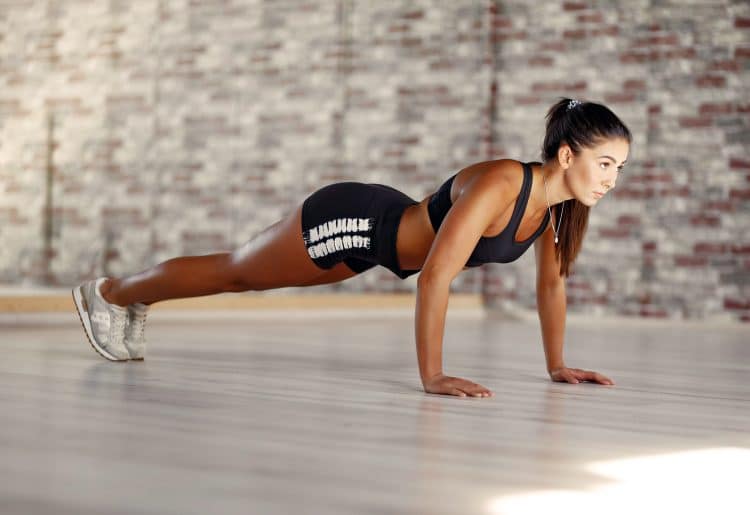High-intensity interval training (HIIT) is a type of cardiovascular training method that prioritizes the anaerobic energy system. It includes short and intense bursts of activity followed by shorter low-intensity or complete rest periods. (1)
I have used HIIT for dozens of clients looking to drop body weight and improve their fitness. As a strength coach in the division one sector of college sports, I frequently used HIIT training to condition my athletes and prepare them for sport while balancing a strength training program. The short and efficient nature of HIIT makes it perfect to do so.
In this article, we will go over the benefits of HIIT and why it is so effective for weight loss. We will also review my favorite and most effective HIIT workouts that you can incorporate into your weight loss routine.
What are the Benefits of HIIT?
There are a host of benefits to incorporating HIIT workouts into your training. These benefits range from time efficiency, starting the EPOC phenomenon, a combination of fat loss and muscle preservation, enhanced insulin sensitivity and glucose regulation, increased metabolic activity, and burning calories throughout the day. (2,3)
This is not an exhaustive list of every benefit of HIIT; however, each one plays a critical part in why HIIT can be so powerful in driving weight loss and, more importantly, fat loss.
Level Up Your Fitness: Join our 💪 strong community in Fitness Volt Newsletter. Get daily inspiration, expert-backed workouts, nutrition tips, the latest in strength sports, and the support you need to reach your goals. Subscribe for free!
What are the Best HIIT Workouts For Weight Loss?
Here are some examples of different kinds of HIIT workouts for weight loss. Give them a shot for a great workout, but please modify weights as needed and prioritize great form to prevent injury.
EMOM (Every Minute on the Minute)
12-Minute EMOM (Beginner)
- Odd (including 0:00): 30 Air Squats
- Even: 30 No Push-Up Burpees
12-Minute EMOM (Advanced)
- Odd (Including 0:00): 30 Front Squats 75/55 (Male/Female)
- Even: 30 Burpee to a 6″ touch
An EMOM workout is a type of HIIT that consists of performing a movement at the top of every minute. Within the EMOM, you can have a single movement that you perform repeatedly or several movements that you cycle through for several rounds.
In a typical EMOM, you will perform an exercise and then get to rest for the remainder of the minute. The length of EMOM workouts can range from a few minutes up to 60 minutes or more, depending on the type of workout that you are doing. But, to keep things high-intensity, I have typically used time frames of 5 to 20 minutes.
The main benefits of an EMOM-style workout are that you know exactly how long it will last and have a good idea of how much work you’ll do. Intensity can also be kept high since there will be programmed rest between each movement.
When programming an EMOM workout, you must ensure your work is repeatable. The last thing you want is to start at a hot pace and then be unable to finish the required number of repetitions before the minute is up. If this happens, then it is no longer an EMOM-style workout. A good target for the duration of work in a HIIT-style EMOM is 30 to 45 seconds of work.
Tabata Intervals
Beginner:
8 Rounds each: 20 seconds on and 10 seconds off
- Assault bike for calories
- Box step-ups 24″/20″ (male/female)
Advanced:
8 rounds each: 20 seconds on and 10 seconds off
- Assault bike for calories
- Box jump step-downs
- Hand release push-ups
Tabata intervals were made famous by Dr. Izumi Tabata, a researcher who worked with the National Institute of Fitness and Sports in Tokyo, Japan (5). In 1996, Dr. Tabata researched the benefits of HIIT and developed the well-known Tabata protocol.
The study used an interval format of 20 seconds of high-intensity work and 10 seconds of rest for eight rounds. This format allowed the subjects to perform the most work possible and train their aerobic and anaerobic energy systems.
The main benefit of Tabata intervals is that they are short. A single Tabata workout could only last four minutes since the workout will call for eight rounds that are thirty seconds long. Also, since the work-to-rest ratio does not allow you to rest for long, the aerobic energy system is challenged in addition to the anaerobic system.
If you wish to increase the length of your workout, you can add exercises in a row so that once eight rounds are completed for the first exercise, you can begin another set for a different exercise.
But, a common pitfall I see with Tabata intervals is going out too fast initially because you are only working for twenty seconds. Since the rest is less time than the work, you will almost certainly burn out if you do not pace yourself. So, it is best to move at a fast pace but not an all-out pace if you aren’t sure you can sustain it for eight rounds.
AMRAP (As Many Rounds As Possible)
Beginner:
5 sets; rest 2 minutes between bouts
- 2-minute AMRAP
- 8 calorie row
- 20 mountain climbers
- 10 air squats
Advanced:
5 sets; rest 1 minute between bouts
- 2-minute AMRAP
- 8 calorie row
- 8 toes to bar
- 10 goblet squats 50/35 (male/female)
An AMRAP workout is a type of HIIT workout where you will try to maximize the amount of work you can do in a given period before resting and beginning again. An AMRAP is similar to a Tabata interval, but the main difference is that in an AMRAP interval, you usually perform more than one movement.
Within a given time frame, you will get as many rounds or repetitions of a given amount of work as possible, followed by a short rest and repeating the work for a given number of sets. The main benefit of an AMRAP workout is that you can train multiple movement patterns. You also have more time than a workout, like Tabata intervals, to do a variety of movements.
For example, in a Tabata workout, there may be better options than using a rowing machine because each pull on the rower can chew up valuable time. Thus, a faster cycle rate exercise, such as the bike or fast bodyweight movements, would be better.
Just like with any HIIT workout, you will want to keep the pace fast but sustainable. For AMRAP workouts, a good rule of thumb is to start at a one-to-one work-to-rest ratio and decrease rest over time.
Chipper Intervals
Beginner:
5 sets; rest 2 minutes between bouts
- 50 Single unders
- 15 Kettlebell swings 53/35
- 10 Hanging knees to waist
- 5 Burpees
Advanced:
5 sets; rest 2 minutes between bouts
- 50 Double unders
- 14 Alternating dumbbell snatch 50/35
- 10 Toes to bar
- 5 Burpees
Chipper workouts are the opposite of AMRAP workouts, as they prioritize tasks instead of time. This means you’ll do some work as quickly as possible, rest for a given time, and repeat that for several sets.
Chipper workouts can be a great way to challenge yourself because they require significant muscle endurance and anaerobic fitness. During a chipper-style HIIT workout, you must complete a given number of repetitions of a particular exercise before moving on to the next, unlike AMRAP workouts, where you will alternate movements to allow for rest to a working muscle group. This aspect of chipper intervals makes them particularly challenging.
As a general rule of thumb, you will want to start with as close to a one-to-one work-to-rest ratio as possible and select a total number of repetitions that you can complete per exercise in a maximum of three sets so that you can keep your pace high and not get bottlenecked by muscle fatigue.
You Go, I Go
Beginner:
For time (Alternate partners each round)
20 rounds
- 10 Calorie row
- 5 Dumbbell front squats 50/35 (male/female)
- 5 Push-ups
- 5 Sit-ups
Advanced:
For time (Alternate partners each round)
20 rounds
- 10 Calorie SkiErg
- 6 Thrusters 75/55
- 6 Push press 75/55
- 5 Sit-ups
The “You Go, I Go” format is a great way to add fun to your workouts with a partner. Only your imagination limits partner workouts, which often involve a given amount of work split between two people who alternate performing the repetitions. The workout will continue until you finish the total number of repetitions or the clock runs out.
Level Up Your Fitness: Join our 💪 strong community in Fitness Volt Newsletter. Get daily inspiration, expert-backed workouts, nutrition tips, the latest in strength sports, and the support you need to reach your goals. Subscribe for free!
The great thing about partner workouts is that you don’t necessarily need to program actual intervals because alternating bouts of work will create its work-to-rest ratio.
However, the tricky part about partner workouts is that they typically require both partners to either be of the same fitness level or accurately scale the exercises to their respective abilities so that each person completes an equal number of repetitions in a similar amount of time. This way, the work-to-rest ratios are kept even between partners.
Fartlek Runs
Beginner:
5 rounds:
- 2-minute jog
- 1-minute sprint
Advanced:
7 rounds:
- 2-minute jog
- 2-minute sprint
Fartlek runs are a type of HIIT that is done via running only. The workout will typically consist of constant movement, whether walking, jogging, running, or sprinting, but intensities alternate based on various factors in your surroundings.
For example, you may be running on a sidewalk and decide to use the telephone poles as markers to change speeds or be circling a football field or track and sprinting the lengths of the field and jogging the widths.
Fartlek runs are an excellent option if you love to run or are aiming for weight loss to be better at running since it is sport-specific to that activity. But even if you are not a runner, running is an excellent choice if you are trying to lose weight because of how many muscles are involved and the calories that running can burn in a typical workout.
I enjoy using Fartlek runs at a track. The oval nature of the track allows for easy changes in pace, unlike a football field with sharp corners. A track is also a level surface, so you can push your pace without worrying about cracks in a sidewalk or oncoming traffic.
Interval Weight Lifting
Beginner:
4 rounds
- 30-second max reps goblet squats
- 30-second rest
- 30-second reps dumbbell walking lunges
- 30-second rest
- 30-second weighted push-ups
- 30-second rest
- 30-second Inverted row
- 30-second rest
** Select weights at a 5/10 RPE (rating of perceived exertion)
Advanced:
4 rounds
- :30-second max reps front squats
- 30-second rest
- 30-second max reps dumbbell step-ups
- 30-second rest
- 30-second bench press
- :30-second rest
- 30-second hammer strength row
- 30-second rest
** Select weights at a 5/10 RPE (rating of perceived exertion)
Interval weight lifting is very similar to the HIIT workout styles that we have discussed thus far. Still, the critical difference is that it focuses on using major compound strength lifts rather than other cyclical or body weight modalities.
The main benefit of interval weight lifting is that it can be a great way to build strength and muscle mass while improving cardiovascular conditioning because you are using relatively higher loads. However, they can also be tremendous for shedding body fat because of the hormonal response to weight lifting under fatigue.
During weight lifting with high volume and minimal rest, there are large outputs of hormones like testosterone and human growth hormone that significantly impact shedding body fat and weight loss. (6)
However, the key to interval weight lifting is being a master of the compound lifts you are performing and selecting weights appropriate for you to be doing under fatigue.
The last thing you want to do is perform high-load back squats under fatigue when you are just learning them. A better option would be to select exercises that use external weights but promote great form.
Ascending Ladders
Beginner:
2-minute running clock; 2-minute rest; 6 total rounds
2, 4, 6, 8, 10…
- Air Squat
- Push Up
- Hanging Knees to waist
Advanced:
2-minute running clock; 2-minute rest; 6 total rounds
2, 4, 6, 8, 10…
- Hang dumbbell squat clean
- Burpee over dumbbell
- Toes to bar
Ascending ladders are a type of HIIT workout in which the repetitions per exercise climb with each successive round. They are a great mental and physical challenge because the total work increases with each set. So, your anaerobic energy system and muscle endurance are challenged as the sets increase.
In a typical ascending ladder HIIT workout, you start with a low number of repetitions until the work is almost meaningless. Then, add several repetitions every time you return to that exercise.
The key to a quality ascending ladder workout is to pick a repetition increase that makes sense for the movement. For example, for a weight-lifting movement such as kettlebell swings, adding a repetition or two may only be appropriate each round. But you would be better served for fifty or so meters for a rowing erg. Any more, and you would spend most of your time rowing.
How Does HIIT Boost Weight Loss?
The following factors are at play:
Increased Consistency
Consistency is the primary factor that leads to results in the gym, and it is no secret that life can get busy. When it does, your fitness training can often fall to the waist side. However, HIIT training can be an excellent way to remain consistent with your workouts because it can be time-efficient. (3)
Getting a great HIIT workout in 10 to 12 minutes is not uncommon. This makes it more accessible for busy people and helps maintain a high-calorie burn over time.
Enhanced Metabolic Rate
The intense nature of HIIT training causes an uptick in metabolic rate throughout the day due to the need for muscles to recover, a return to baseline body temperature, and the elevated levels of hormones in the body. (2)
Excess Post-Exercise Oxygen Consumption (EPOC)
EPOC is a powerful phenomenon that drives weight loss after intense exercise. It results from energy production in the absence of oxygen. (2) This “oxygen debt” must be paid back, and increasing caloric burn to do so results in increased caloric burn and, ultimately, weight loss.
Improved Insulin Sensitivity
HIIT training can improve insulin sensitivity through various mechanisms. Most notably through increased glucose demand by the muscles during and after exercise and increased activation of GLUT4. (4)
Final Thoughts on HIIT Workouts For Weight Loss
There are a variety of ways that you can perform HIIT workouts. They can benefit your weight loss journey regardless of how you perform them. Above are the top HIIT styles that I have used in my training and for my clients.
Although HIIT may seem simple, and you might want to hit the clock and go as hard as possible, there are things to consider to maintain a high-quality workout, like exercise selection, choosing weights, and total volume.
Use this article as a guide. If you try the workouts I have provided, please be sure to perform the variation that most suits your ability and modify the weights as needed to be done safely.
If you are unsure how to do so, please seek guidance or work with a professional fitness coach in your area so that you can safely reap all of the benefits of HIIT workouts!
References:
- Buchheit, M., & Laursen, P. B. (2013). High-intensity interval training, solutions to the programming puzzle: Part I: cardiopulmonary emphasis. Sports medicine (Auckland, N.Z.), 43(5), 313–338. https://doi.org/10.1007/s40279-013-0029-x
- Greer, B. K., O’Brien, J., Hornbuckle, L. M., & Panton, L. B. (2021). EPOC Comparison Between Resistance Training and High-Intensity Interval Training in Aerobically Fit Women. International journal of exercise science, 14(2), 1027–1035. https://pubmed.ncbi.nlm.nih.gov/34567357/
- Wewege, M., van den Berg, R., Ward, R. E., & Keech, A. (2017). The effects of high-intensity interval training vs. moderate-intensity continuous training on body composition in overweight and obese adults: a systematic review and meta-analysis. Obesity reviews : an official journal of the International Association for the Study of Obesity, 18(6), 635–646. https://doi.org/10.1111/obr.12532
- Jelleyman, C., Yates, T., O’Donovan, G., Gray, L. J., King, J. A., Khunti, K., & Davies, M. J. (2015). The effects of high-intensity interval training on glucose regulation and insulin resistance: a meta-analysis. Obesity reviews : an official journal of the International Association for the Study of Obesity, 16(11), 942–961. https://doi.org/10.1111/obr.12317
- Tabata I. (2019). Tabata training: one of the most energetically effective high-intensity intermittent training methods. The journal of physiological sciences : JPS, 69(4), 559–572. https://doi.org/10.1007/s12576-019-00676-7
- Kraemer, W. J., & Ratamess, N. A. (2005). Hormonal responses and adaptations to resistance exercise and training. Sports medicine (Auckland, N.Z.), 35(4), 339–361. https://doi.org/10.2165/00007256-200535040-00004












